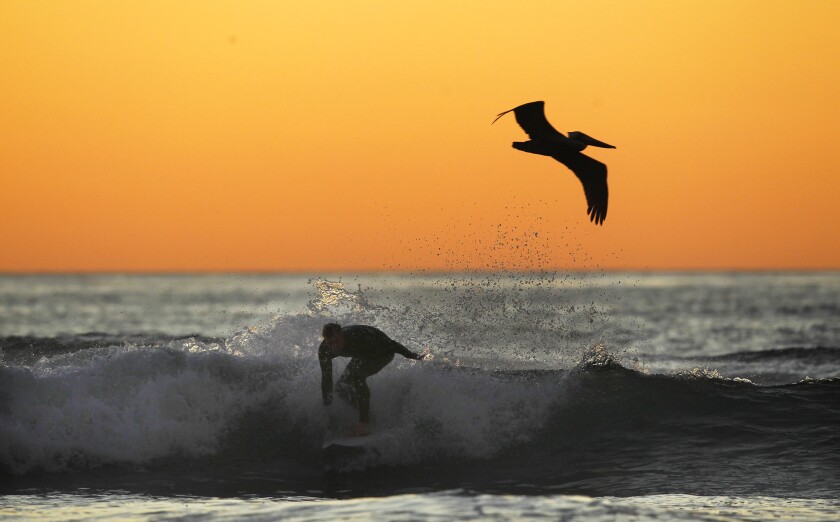A local doctoral student has turned his penchant for pelican watching into a mathematical model of energy use that has possibilities beyond the waves. It might even help drones fly better.
Ian Stokes, a Ph.D. student in mechanical engineering at UC San Diego, developed a theoretical model for how pelicans use physics to stay in flight and recently published his findings as the lead author of a paper titled “Wave-slope soaring of the brown pelican.”
The paper, published March 22 in Movement Ecology and written with help from Stokes’ advisor, Drew Lucas of the Scripps Institution of Oceanography in La Jolla, details how pelicans use energy generated by the ocean waves to conserve their own — flapping less and gliding more.

UC San Diego Ph.D. student Ian Stokes created a mathematical model for how pelicans exploit waves while gliding.
(Gary Robbins / The San Diego Union-Tribune)
“What happens is the wave comes by and it lifts the air in front of it, as well as creating horizontal flow,” Stokes said, “and from there we get ... what we call wave-induced wind.”
“You put the pelican in that situation … you can estimate how much energy it can gain or how much energy you can save by using that updraft.”
Stokes likened pelicans’ use of wave energy to the paragliders at the Torrey Pines Gliderport who drift midair using the onshore winds.
“The wind hits the cliff and it accelerates up the face of the cliff. It gets redirected upward and then the paragliders and the birds and whoever else can use that updraft to stay aloft,” Stokes said.
The pelicans, however, glide in an “alternative case where, rather than a stationary cliff in a moving atmosphere, you have a stationary atmosphere and a moving ... wave,” he said.
Pelicans “can fly right along the wave crest for a really long time without flapping at all,” he added. “They’re basically surfing the wave; it’s pretty sweet to watch.”

Pelicans fly along the water as a surfer takes a wave off La Jolla.
(K.C. Alfred / The San Diego Union-Tribune)
The refined equations and the pelicans’ behavior might be used to improve drone flight, Stokes said.
“Biomimicry is a huge field,” he said. “Why not use the millions of years of ... evolution to inspire our design [of technology]?”
He said drone developers have long studied albatross flight, which exploits above-ocean winds that are “faster up high and slower down low.”
The albatross will “fly up through the slower wind speed and turn around and accelerate through the higher wind speed and then swoop back down through the lower wind speed,” which means the birds “can actually track forward so that through this whole process, they’re not flapping and they’re able to travel for extremely long distances.”
“Drone people love it” because it provides technology developers a model for conserving energy and lengthening flight times, Stokes said.
Incorporating the pelicans’ wave-slope soaring could advance drone programming, he said. “They [might] say, ‘If it’s windy, we’ll use the albatross flight. And if it’s not windy, we’ll use the pelican flight.’”

A pelican and a surfer pass each other at Windansea Beach in La Jolla.
(K.C. Alfred / The San Diego Union-Tribune)
To those who worry that drones cannot feasibly fly as close to the water as pelicans, Stokes said “our model kind of shows that you don’t have to be that close to get a benefit. You could be 10 feet above the wave and you could still be getting some amount of help from the updraft because the updraft actually extends pretty high into the atmosphere.”
To shore up the project, Stokes said, “someone would have to actually strap a pelican up with instruments” to record its flight and test his theory, though he said he’s no ornithologist.
“I’m more interested in oceanography and climate change,” he said, particularly internal ocean dynamics. “There’s actually a lot of waves inside the ocean.”
And the ones he studied above the surface, under the pelicans? “A cool exercise in physics,” he said.
Stokes began exploring pelicans’ use of wave energy while completing his undergraduate degree in physics at UC Santa Barbara, watching the birds surf the air as he surfed the waves in his off time.
He completed a “baby version” of his study then as a senior project, he said.
Lucas encouraged him to build on his mathematical model in graduate school, so he met with a team of Scripps Oceanography researchers, including the now-late Ken Melville, who suggested using the Korteweg–De Vries, or KdV, model for a nonlinear wave.
“That’s what gives our paper a lot of credibility,” Stokes said, “because it’s not like the simplest model in the world. … The math gets pretty hectic.” ◆
"can" - Google News
April 30, 2021 at 06:01AM
https://ift.tt/3e2iZHm
Can UCSD doctoral student's findings on pelicans' 'wave-slope soaring' give drones a lift? - La Jolla Light
"can" - Google News
https://ift.tt/2NE2i6G
https://ift.tt/3d3vX4n
Bagikan Berita Ini














0 Response to "Can UCSD doctoral student's findings on pelicans' 'wave-slope soaring' give drones a lift? - La Jolla Light"
Post a Comment